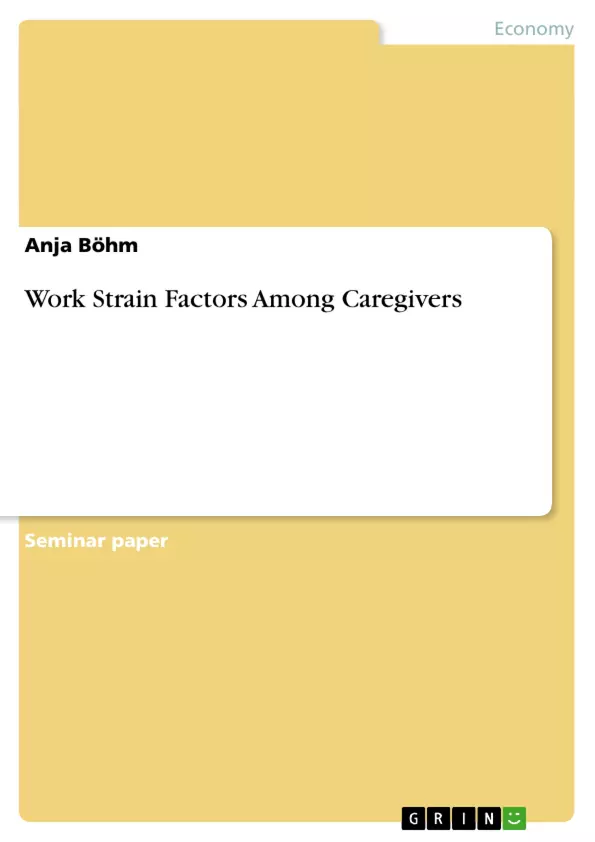The demographic change within the German population and the increasing number of geriatric multimorbid diseased patients will cause a rising demand for nursing care in the future. At the same time the number of young nurses to provide care in nursing homes will decrease. Therefore, nurses for the elderly should be able to remain working healthy in their jobs as long as possible.
Concerning the physical work strains, geriatric nurses often have to work standing, in strenuous posture or have to lift and carry weights, which exceed 10 kilograms for women. These strains can result in health disorders of the neck, shoulders and lower back.
Concerning the mental work strains, nurses seem to handle the present emotional requirements from disease, suffering and death quite well and perceive handling aggressive and uncooperative residents as being more challenging. These behaviors are mainly shown by residents, who suffer from dementia. When being discontent with the quality of care, geriatric nurses seem to burn out faster compared to content nurses for the elderly.
Concerning the organizational work strains, staff shortage and the linked time pressure are perceived as stressful by geriatric nurses. Nurses for the elderly perceive having too little time for the residents’ psychosocial support, which reduces the perceived quality of care and hence leads to discontent, which might result in burn-out.
Therefore, the status of employees’ sickness of geriatric nurses is above average. This tendency can be perceived in both, cases of illness as well as in average endurance. Regarding the underlying diseases, diseases of the muscles and the skeleton system, of the respiratory system and of the psyche are the most important ones.
To reduce these work strains and thus improve the employees’ health status, several measurements should be conducted by employers. These compass providing devices for avoiding physical work strains from carrying, lifting and turning residents. To avoid mental work strains, employees should be able to participate by making suggestions, when planning the service schedule, receive training and have professional leaders who obtain core leadership competencies.
Inhaltsverzeichnis (Table of Contents)
- Executive Summary
- Table of Contents
- List of Figures
- List of Abbreviations
- Introduction
- Methodology
- Research objectives
- Research steps
- Results
- Presentation of the German care market
- Employees within nursing homes
- Current requirements within nursing homes
- Work strains
- Physical work strains
- Mental work strains
- Organizational work strains
- Implications of work strains
- Status of employees' sickness
- Status of employee's sickness according to age and gender
- Specific diseases
- Costs
- Presentation of the German care market
- Conclusions
- Recommendations
- Bibliography
Zielsetzung und Themenschwerpunkte (Objectives and Key Themes)
This research paper explores the work strain factors experienced by caregivers, particularly geriatric nurses, in Germany. It examines the current situation in nursing homes, including the increasing demand for care, limited resources, and rising job requirements. The paper also delves into the specific physical, mental, and organizational work strains that contribute to caregiver stress, as well as the consequences for employee health and well-being. Key themes explored in the paper include:- The challenges of providing care to an aging population in Germany, marked by increasing demand and limited resources.
- The specific work strain factors experienced by geriatric nurses, including physical demands, emotional challenges, and organizational pressures.
- The impact of work strain on the health and well-being of geriatric nurses, particularly in terms of illness rates and specific health conditions.
- The need for effective strategies and measures to mitigate work strain and improve the working conditions for geriatric nurses.
Zusammenfassung der Kapitel (Chapter Summaries)
The paper begins by outlining the increasing demand for geriatric care in Germany, driven by demographic change and rising rates of multimorbidity. This trend puts a strain on nursing homes, which are facing limited financial resources and an aging workforce. Chapter 3 delves into the specific work strain factors experienced by geriatric nurses. It analyzes the physical, mental, and organizational challenges, highlighting the impact on employee health and well-being. Chapter 4 examines the status of employee sickness among geriatric nurses, including the prevalence of specific health conditions and associated costs. The paper concludes with recommendations aimed at mitigating work strain and improving working conditions for geriatric nurses.Schlüsselwörter (Keywords)
This research paper focuses on the challenges faced by geriatric nurses in Germany, exploring work strain factors, health consequences, and strategies for improvement. Key terms include: work strain, geriatric care, nursing homes, physical work strain, mental work strain, organizational work strain, employee health, sickness rates, and health conditions.- Quote paper
- Anja Böhm (Author), 2009, Work Strain Factors Among Caregivers, Munich, GRIN Verlag, https://www.grin.com/document/134453



